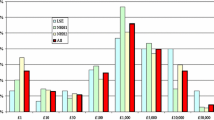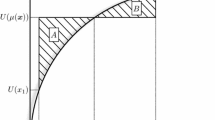Abstract
The idea of using as a basis for deriving social preferences about income distributions the choices that an individual would make in a hypothetical situation in which he had an equal chance of being put in the place of any member of society has a long tradition in economics. Harsanyi (1953, 1955), most notably, argued that the value judgements underlying that type of choice would be consistent with those of an impartial spectator in the narrower tradition of classical utilitarianism (David Hume 1740, Adam Smith 1759). We provide questionnaire evidence that, although there is a strong affinity between the two types of value judgement, neither is utilitarian, that is, consistent with an additively separable social welfare function. In fact, we found violations of utilitarianism qualitatively similar to those against the expected utility model for choice under risk, like those entailed in the Allais Paradox and other well known violations (including those against the Betweenness axiom). Our questionnaire also gives evidence of violations of some of the principles most used to measure and value inequality in a society, like the Pigou-Dalton Principle of Transfer and the Pareto unanimity rule. In a concluding paragraph we discuss certain similarities between the violations of the expected utility axioms and those of these more basic principles.
Similar content being viewed by others
References
Allais, M. (1953): “Le comportement de l'homme rationnel devant le risque: critique des postulates et axiomes de l'école americaine.”Econometrica 21: 503–556.
Amiel, Y., and Cowell, F. A. (1992): “Measurement of Income Inequality. Experimental Test by Questionnaire.”Journal of Public Economics 47: 3–26.
Amiel, Y., and Cowell, F. A. (1994a): “Inequality Changes and Income Growth.” InMeasurement of Welfare and Inequality, edited by W. Eichhorn. Berlin: Springer-Verlag.
Amiel, Y., and Cowell, F. A. (1994b): “Monotonicity, Dominance and the Pareto Principle.”Economics Letters 45: 447–450.
Amiel, Y., and Cowell, F. A. (1998): “Distributional Orderings and the Transfer Principle.”Research on Economic Inequality 8: 195–215.
Amiel, Y., and Cowell, F. A. (1999):Thinking About Inequality. Cambridge: Cambridge University Press.
Arrow, K. J. (1963):Social Choice and Individual Values, 2nd edn. New York: John Wiley & Sons.
Atkinson, A. B. (1970): “On the Measurement of Inequality.”Journal of Economic Theory 2: 244–263.
Bell, D. (1985): “Disappointment in Decision making under Uncertainty.”Operations Research 33: 1–27.
Bentham, J. (1789):An Introduction to the Principles of Morals and Legislation. Reprint edited by J. Burns and L. Hart (1970). London: Athlone Press.
Bernasconi, M. (1994): “Nonlinear Preferences and Two-stage Lotteries: Theories and Evidence.”Economic Journal 104: 54–70.
Camerer, C. (1995): “Individual Decision Making.” InHandbook of Experimental Economics, edited by J. H. Kagel, and A. E. Roth. Princeton, NJ: Princeton University Press.
Camerer, C., and Ho, T. H. (1994): “Violations of the Betweenness Axiom and Nonlinearity in Probability.”Journal of Risk and Uncertainty 8: 167–196.
Camerer, C., and Hogarth, R. M. (1999): “The Effects of Financial Incentives in Experiments: A Review and Capital-Labor-Production Framework.”Journal of Risk and Uncertainty 19: 7–42.
Chew, S. H. (1983): “A Generalization of the Quasilinear Mean with Applications to the Measurement of the Income Inequality and Decision Theory Resolving the Allais Paradox.”Econometrica 53: 1065–1092.
Chew, S. H., Epstein, L. G., and Segal, U. (1991): “Mixture Symmetry and Quadratic Utility.”Econometrica 59: 139–163.
Chew, S. H., Epstein, L. G., and Zilcha, I. (1988): “A Correspondence Theorem between Expected Utility and Smooth Utility.”Journal of Economic Theory 46: 186–193.
Conlisk, J. (1987): “Verifying the Betweenness Axiom with Questionnaire Evidence, or Not: Take Your Pick.”Economics Letters 25: 319–322.
Conlisk, J. (1989): “Three Variants on the Allais Example.”American Economic Review 79: 392–407.
Dalton, H. (1920): “The Measurement of the Inequality of Incomes.”Economic Journal 30: 348–361.
Dekel, E. (1986): “An Axiomatic Characterization of Preference Under Uncertainty: Weakening the Independence Axiom.”Journal of Economic Theory 40: 304–318.
Diamond, P. A. (1967): “Cardinal Welfare, Individualistic Ethics, and Intertemporal Comparisons of Utility: Comment.”Journal of Political Economy 75: 765–766.
Eichhorn, W. (ed.) (1994):Inequality Changes and Income Growth. Berlin. Springer-Verlag.
Epstein, L. G. (1992): “Behavior under Risk: Recent Developments in Theory and Applications.” InAdvances in Economic Theory, edited by J. J. Laffont. Cambridge: Cambridge University Press.
Epstein, L. G., and Segal, U. (1992): “Quadratic Social Welfare Functions.”Journal of Political Economy 100: 691–712.
Frohlich, N., and Oppenheimer, J. O. (1992):Choosing Justice: An Experimental Approach to Ethical Theory. Berkeley and Los Angeles: University of California Press.
Gul, F. (1991): “A Theory of Disappointment Aversion.”Econometrica 59: 667–687.
Hadar, J., and Russell, W. R. (1969): “Rules for Ordering Uncertain Prospects.”American Economic Review 59: 25–34.
Hammond, P. (1988): “Consequentialist Foundations for Expected Utility.”Theory and Decision 25: 25–78.
Harrison, E., and Seidl, C. (1994a): “Perceptional Inequality and Preferential Judgments: An Empiricial Examinition of Distributional Axioms.”Public Choice 79: 61–81.
Harrison, E., and Seidl, C. (1994b): “Acceptance of Distributional Axioms: Experimental Findings.” InModels and Measurement of Welfare and Inequality, edited by W. Eichorn. Berlin: Springer-Verlag.
Harsanyi, J. C. (1953): “Cardinal Utility in Welfare Economics and in the Theory of Risk-Taking.”Journal of Political Economy 61: 434–435.
Harsanyi, J. C. (1955): “Cardinal Welfare, Individualistic Ethics and Interpersonal Comparisons of Utility.”Journal of Political Economy 63: 309–321.
Harsanyi, J. C. (1977a):Rational Behavior and Bargaining Equilibrium in Games and Social Situations. Cambridge: Cambridge University Press.
Harsanyi, J. C. (1977b): “Morality and the Theory of Utilities, Risk Taking and Welfare.”Social Research 44: 623–656.
Harsanyi, J. C. (1987): “Von Neumann-Morgenstern Utilities, Risk Taking and Welfare.” InArrow and the Ascent of Modern Economic Theory, edited by G. R. Feiwel. London: Macmillan.
Hume, D. (1740):A Treatise of Human Nature. Edited by L. A. Selby-Bigge (1978). Oxford: Clarendon Press.
Kahneman, D., and Tversky, A. (1979): “Prospect Theory: An Analysis of Decision under Risk.”Econometrica 47: 263–291.
Kolm, S. C. (1976): “Unequal Inequalities II.”Journal of Economic Theory 13: 82–111.
Lambert, P. (1989):The Distribution and Redistribution of Income. Oxford: Basil Blackwell. 2nd. edition, 1993. Manchester: Manchester University Press.
Loomes, G., Starmer, C., and Sugden, R. (1992): “Are Preferences Monotonic? Testing Some Predictions of Regret Theory.”Economica 59: 17–33.
Loomes, G., and Sugden, R. (1986): “Disappointment and Dynamic Consistency in Decision Making under Uncertainty.”Review of Economic Studies 53: 271–282.
Machina, M. J. (1982): “Expected Utility Analysis Without the Independence Axiom.”Econometrica 50: 277–323.
Machina, M. J. (1989): “Dynamic Consistency and Non-Expected Utility Models of Choice Under Uncertainty.”Journal of Economic Literature 27: 1622–1668.
Pattanaik, P. K. (1968): “Risk, Impersonality, and the Social Welfare Function.”Journal of Political Economy 76: 1152–1169.
Pigou, A. C. (1912):Wealth and Welfare. New York: Macmillan.
Rawls, J. (1971):A Theory of Justice. Cambridge, Mass.: Harvard University Press.
Rothschild, M., and Stiglitz, J. (1970): “Increasing Risk: I. A Definition.”Journal of Economic Theory 2: 225–243.
Rothschild, M., and Stiglitz, J. (1973): “Some Further Results on the Measurement of Inequality.”Journal of Economic Theory 6: 188–204.
Schokkaert, E., and Overlaet, L. (1989): “Moral Intuitions and Economic Modes of Distributive Justice.”Social Choice and Welfare 6: 19–31.
Seidl, C., and Theilen, B. (1994): “Stochastic Independence of Distributional Attitudes and Social Status. A Comparison of German and Polish Data.”European Journal of Political Economy 10: 295–310.
Sen, A. K. (1970):Collective Choice and Social Welfare. San Francisco: Holden Day.
Sen, A. K. (1977): “Non-linear Social Welfare Function: A Reply to Professor Harsanyi.” InFoundational Problems in the Social Sciences, edited by R. E. Butts, and J. Hantikka. Dordrecht: Reidel.
Sen, A. K. (1985): “Rationality and Uncertainty.”Theory and Decision 18: 109–127.
Sen, A. K. (1986): “Social Choice Theory.” InHandbook of Mathematical Economics, edited by K. J. Arrow, and M. D. Intriligator, volume 3. Amsterdam: North-Holland.
Slovic, P., and Tversky, A. (1974): “Who Accepts Savage's Axiom?”Behavioral Science 19: 368–373.
Smith, A. (1959):The Theory of Moral Sentiments. Edited by D. D. Raphael, and A. L. Macfie. Oxford: Clarendon Press.
Weymark, J. A. (1991): “A Reconsideration of the Harsanyi-Sen Debate of Utilitarianism.” InInterpersonal Comparisons and Well-Being, edited by J. E. Elster, and J. E. Roemer. Cambridge: Cambridge University Press.
Yaari, M. E., and Bar-Hillel, M. (1984): “On Diving Justly.”Social Choice and Welfare 1: 1–24.
Author information
Authors and Affiliations
Corresponding author
Rights and permissions
About this article
Cite this article
Bernasconi, M. How should income be divided? questionnaire evidence from the theory of “Impartial preferences”. J. Econ. 77 (Suppl 1), 163–195 (2002). https://doi.org/10.1007/BF03052503
Published:
Issue Date:
DOI: https://doi.org/10.1007/BF03052503




